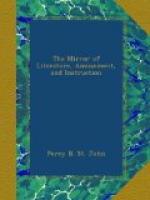Previous to his executing that most magnificent yet most touching piece of sculpture, which alone would have sufficed to immortalize his name, Chantrey was, at his own request, locked up alone in the church for two hours. This fact may be apocryphal; but the following I do affirm most confidently. When I hinted to the venerable matron who shows the monument, and who, being a retainer of the Boothby family, feels their honour identified with her own, that Chantrey’s was by far the finer effort of the two, and that I wished I had that yet to see; and my companion added, that though the design of the Boothby monument was good, the execution was coarse and clumsy in the extreme, compared with the elaborate finish of the Robinson’s. “Humph,” said the old lady, with a most vinegar expression of countenance, with a degree of angry hauteur, an air of insulted dignity that Yates would have travelled fifty miles to witness; “the like of that’s what I now hear every day. Hang that fellow Chantee, or Cantee, or what you call him; I wish he had never been born!” The Ashbourne people are naturally proud of the monument. With them it is a kind of idol, to which every stranger is required to do homage. Among others, when Prince Leopold passed through Ashbourne, and inquiries were made by some of his royal highness’s suite as to the “lions” of the neighbourhood—“We have one of our own, Sir,” was the ready reply; “a noble piece of sculpture in the church.” To the church the royal mourner was on the very point of repairing, when Sir Robert Gardiner suddenly inquired the description to which the sculpture in question belonged. “It is a monument, Sir, no one passes through without seeing it; for its like is not to be met with in England—it is a monument to an only child, whose mother died—” “Not now,” said the prince faintly; “not now. I too have lost—” and he turned away from the carriage in tears.
MR. CANNING.
It may be observed, too, by the way, that to Ashbourne the late Mr. Canning was remarkably partial. Near it lived a female relative to whom he was warmly attached, and under whose roof many of his happiest hours were spent. It is stated, that a little poem, entitled, “A Spring Morning in Dovedale,” one of the earliest efforts of his muse, is still in existence; and I have good reasons for knowing, that but a very few weeks previous to his death, he stated, in conversation, what delight he should feel in “going into that neighbourhood, and revisiting haunts which to him had been scenes of almost unalloyed enjoyment.” I could scarcely believe, so exquisitely tranquil is the scene, the very murmur of the stream which flows around seems to soften itself in unison with the stillness of the landscape—that Ashbourne had ever been other than the abode of rural peace and comfort; and yet I was assured that during the war there was scarcely any limit to the bustle and gaiety which pervaded it.




